warning MITSUBISHI COLT 2008 (in English) Repair Manual
[x] Cancel search | Manufacturer: MITSUBISHI, Model Year: 2008, Model line: COLT, Model: MITSUBISHI COLT 2008Pages: 450, PDF Size: 14.57 MB
Page 169 of 450
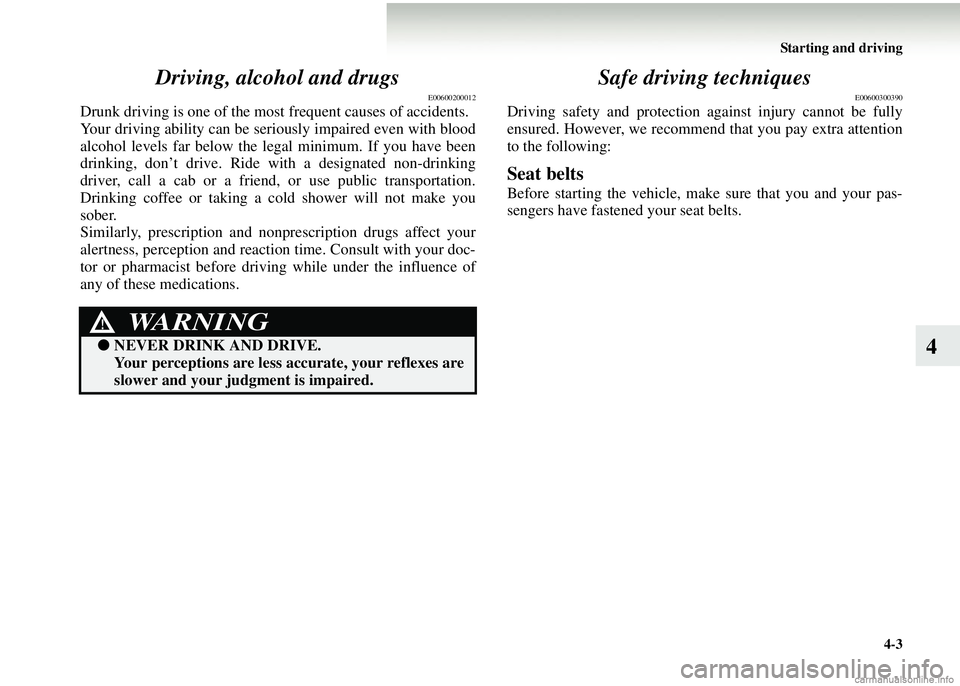
Starting and driving4-3
4
Driving, alcohol and drugs
E00600200012
Drunk driving is one of the most
frequent causes of accidents.
Your driving ability can be seriously impaired even with blood
alcohol levels far below the legal minimum. If you have been
drinking, don’t drive. Ride with a designated non-drinking
driver, call a cab or a friend, or use public transportation.
Drinking coffee or taking a cold shower will not make you
sober.
Similarly, prescription and nonprescription drugs affect your
alertness, perception and reaction time. Consult with your doc-
tor or pharmacist before driving while under the influence of
any of these medications.
Safe driving techniques
E00600300390
Driving safety and protection against injury cannot be fully
ensured. However, we recommen d that you pay extra attention
to the following:
Seat belts
Before starting the vehicle, make sure that you and your pas-
sengers have fastened your seat belts.
WARNING!
● NEVER DRINK AND DRIVE.
Your perceptions are less accurate, your reflexes are
slower and your judgme nt is impaired.
Page 170 of 450
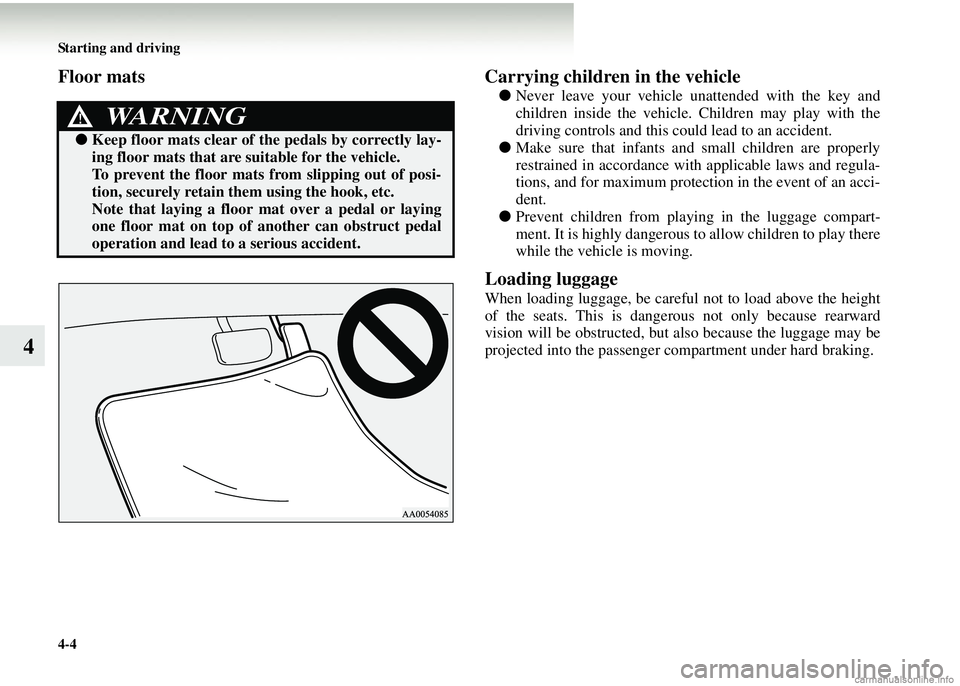
4-4 Starting and driving
4
Floor matsCarrying children in the vehicle
●Never leave your vehicle un attended with the key and
children inside the vehicle. Children may play with the
driving controls and this could lead to an accident.
● Make sure that infants and small children are properly
restrained in accordance with applicable laws and regula-
tions, and for maximum protecti on in the event of an acci-
dent.
● Prevent children fr om playing in the luggage compart-
ment. It is highly dangerous to allow children to play there
while the vehicle is moving.
Loading luggage
When loading luggage, be careful not to load above the height
of the seats. This is dange rous not only because rearward
vision will be obstru cted, but also because the luggage may be
projected into the passenger compartment under hard braking.
WARNING!
● Keep floor mats clear of th e pedals by correctly lay-
ing floor mats that are suitable for the vehicle.
To prevent the floor mats from slipping out of posi-
tion, securely retain th em using the hook, etc.
Note that laying a floor mat over a pedal or laying
one floor mat on top of an other can obstruct pedal
operation and lead to a serious accident.
Page 173 of 450
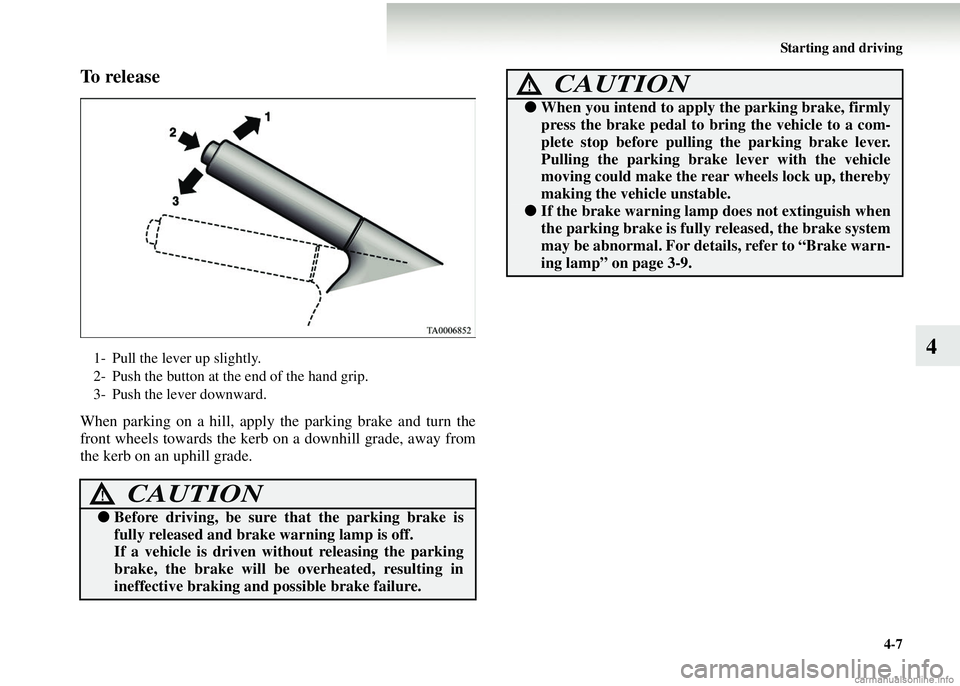
Starting and driving4-7
4
To r e l e a s e
When parking on a hill, apply the parking brake and turn the
front wheels towards the kerb on a downhill grade, away from
the kerb on an uphill grade.
1- Pull the lever up slightly.
2- Push the button at the end of the hand grip.
3- Push the lever downward.
CAUTION!
● Before driving, be sure that the parking brake is
fully released and brake warning lamp is off.
If a vehicle is driven wi thout releasing the parking
brake, the brake will be overheated, resulting in
ineffective brak ing and possible brake failure.
●When you intend to apply the parking brake, firmly
press the brake pedal to bring the vehicle to a com-
plete stop before pullin g the parking brake lever.
Pulling the parking brake lever with the vehicle
moving could make the rear wheels lock up, thereby
making the vehicle unstable.
● If the brake warning lamp does not extinguish when
the parking brake is fully released, the brake system
may be abnormal. For details, refer to “Brake warn-
ing lamp” on page 3-9.
CAUTION!
Page 174 of 450
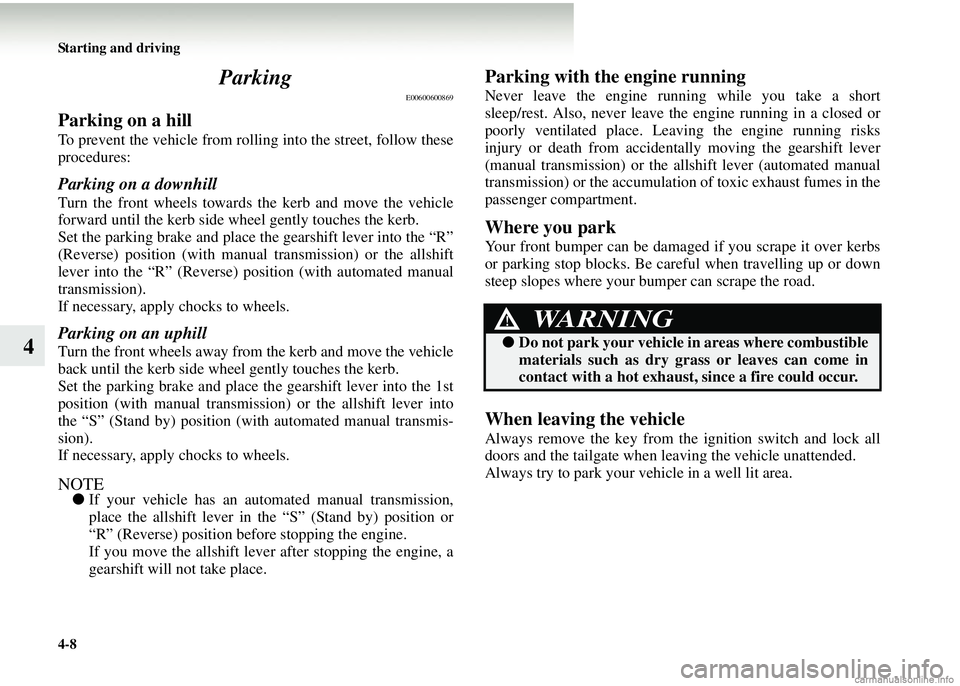
4-8 Starting and driving
4Parking
E00600600869
Parking on a hill
To prevent the vehicle from rolling into the street, follow these
procedures:
Parking on a downhill
Turn the front wheels towards
the kerb and move the vehicle
forward until the kerb side wheel gently touches the kerb.
Set the parking brake and place the gearshift lever into the “R”
(Reverse) position (with manual transmission) or the allshift
lever into the “R” (Reverse) position (with automated manual
transmission).
If necessary, apply chocks to wheels.
Parking on an uphill
Turn the front wheels away from the kerb and move the vehicle
back until the kerb side wheel gently touches the kerb.
Set the parking brake and place th e gearshift lever into the 1st
position (with manual transmission) or the allshift lever into
the “S” (Stand by) position (with automated manual transmis-
sion).
If necessary, apply chocks to wheels.
NOTE● If your vehicle has an automated manual transmission,
place the allshift lever in the “S” (Stand by) position or
“R” (Reverse) position before stopping the engine.
If you move the allshift lever after stopping the engine, a
gearshift will not take place.
Parking with the engine running
Never leave the engine running while you take a short
sleep/rest. Also, never leave the engine running in a closed or
poorly ventilated place. Leaving the engine running risks
injury or death from accidental ly moving the gearshift lever
(manual transmission) or the allshift lever (automated manual
transmission) or the accumulation of toxic exhaust fumes in the
passenger compartment.
Where you park
Your front bumper can be damaged if you scrape it over kerbs
or parking stop blocks. Be careful when travelling up or down
steep slopes where your bumper can scrape the road.
When leaving the vehicle
Always remove the key from the ignition switch and lock all
doors and the tailgate when leaving the vehicle unattended.
Always try to park your vehicle in a well lit area.
WARNING!
● Do not park your vehicle in areas where combustible
materials such as dry grass or leaves can come in
contact with a hot exhaust, since a fire could occur.
Page 175 of 450
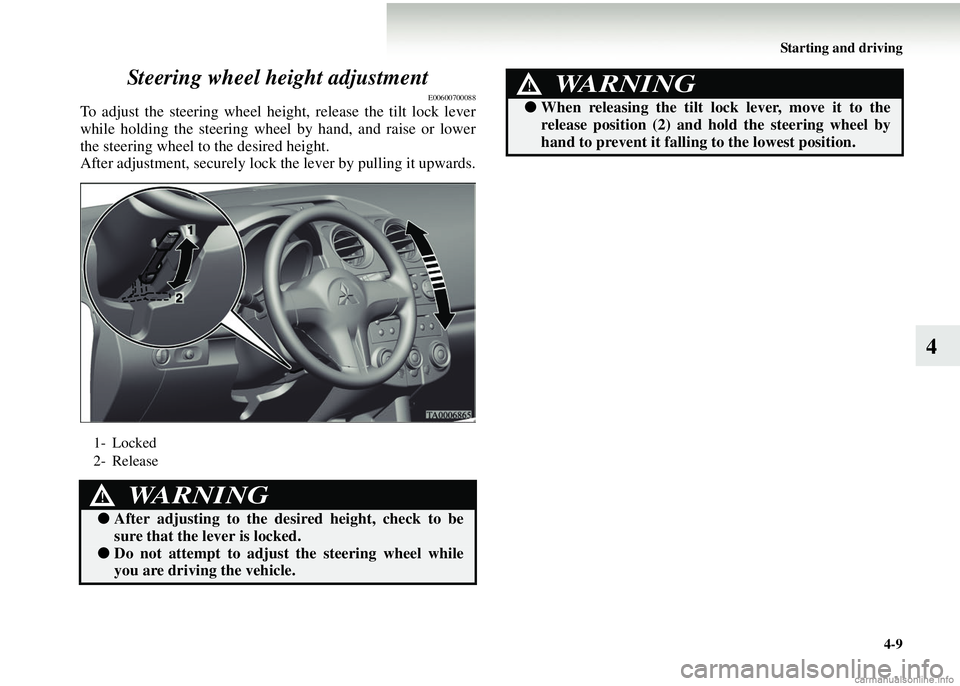
Starting and driving4-9
4
Steering wheel height adjustment
E00600700088
To adjust the steering wheel height, release the tilt lock lever
while holding the steering wheel by hand, and raise or lower
the steering wheel to the desired height.
After adjustment, securely lock the lever by pulling it upwards.
1- Locked
2- Release
WARNING!
●
After adjusting to the desired height, check to be
sure that the lever is locked.
●Do not attempt to adjust the steering wheel while
you are drivin g the vehicle.
●When releasing the tilt lock lever, move it to the
release position (2) and hold the steering wheel by
hand to prevent it falling to the lowest position.
WARNING!
Page 176 of 450
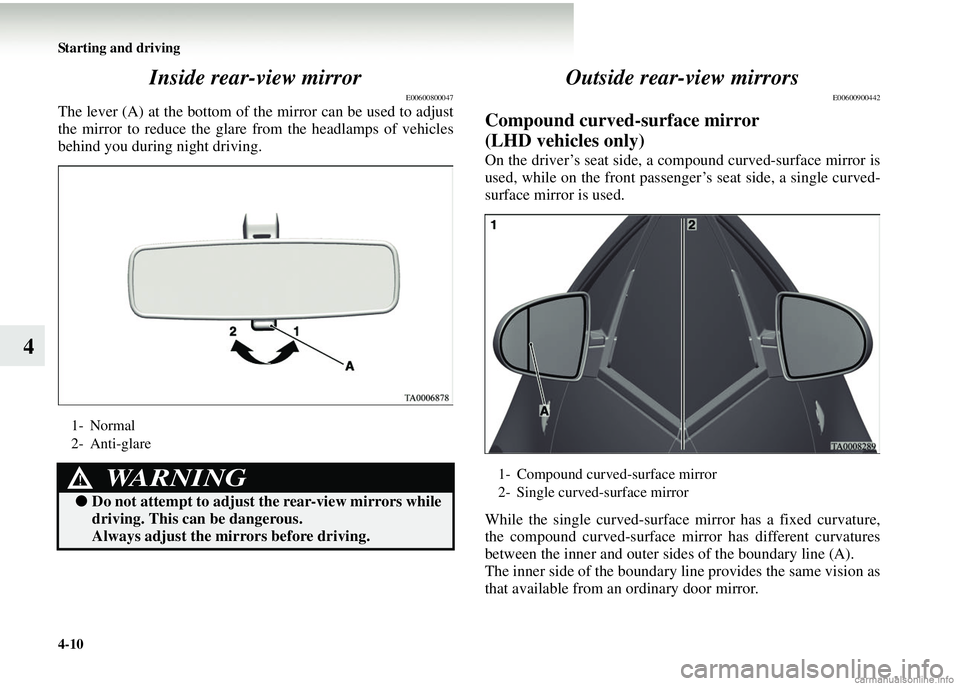
4-10 Starting and driving
4Inside rear-view mirror
E00600800047
The lever (A) at the bottom of th
e mirror can be used to adjust
the mirror to reduce the glare from the headlamps of vehicles
behind you during night driving.
Outside rear-view mirrors
E00600900442
Compound curved-surface mirror
(LHD vehicles only)
On the driver’s seat side, a co mpound curved-surface mirror is
used, while on the front passenger’s seat side, a single curved-
surface mirror is used.
While the single curved-surface mirror has a fixed curvature,
the compound curved-surface mirror has different curvatures
between the inner and outer sides of the boundary line (A).
The inner side of the boundary line provides the same vision as
that available from an ordinary door mirror.
1- Normal
2- Anti-glare
WARNING!
● Do not attempt to adjust the rear-view mirrors while
driving. This can be dangerous.
Always adjust the mirrors before driving.
1- Compound curved-surface mirror
2- Single curved-surface mirror
Page 177 of 450
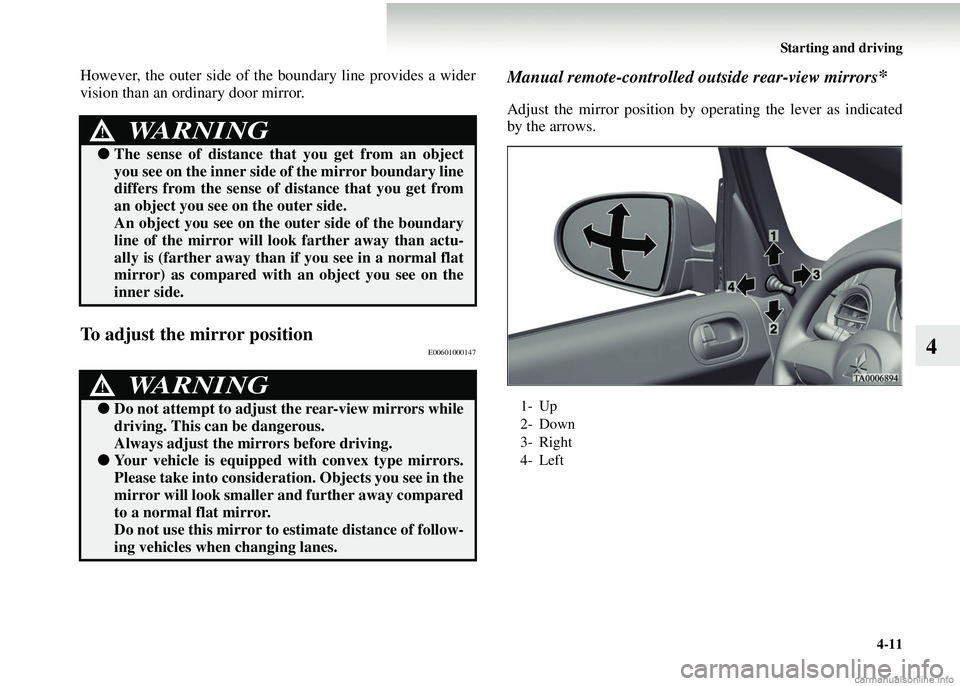
Starting and driving4-11
4
However, the outer side of the boundary line provides a wider
vision than an ordinary door mirror.
To adjust the mirror positionE00601000147
Manual remote-controlled ou tside rear-view mirrors*
Adjust the mirror position by operating the lever as indicated
by the arrows.
WARNING!
●The sense of distance that you get from an object
you see on the inner side of the mirror boundary line
differs from the sense of distance that you get from
an object you see on the outer side.
An object you see on the outer side of the boundary
line of the mirror will lo ok farther away than actu-
ally is (farther away than if you see in a normal flat
mirror) as compared with an object you see on the
inner side.
WARNING!
● Do not attempt to adjust the rear-view mirrors while
driving. This can be dangerous.
Always adjust the mirrors before driving.
●Your vehicle is equipped with convex type mirrors.
Please take into considerati on. Objects you see in the
mirror will look smaller and further away compared
to a normal flat mirror.
Do not use this mirror to estimate distance of follow-
ing vehicles when changing lanes.
1- Up
2- Down
3- Right
4- Left
Page 182 of 450
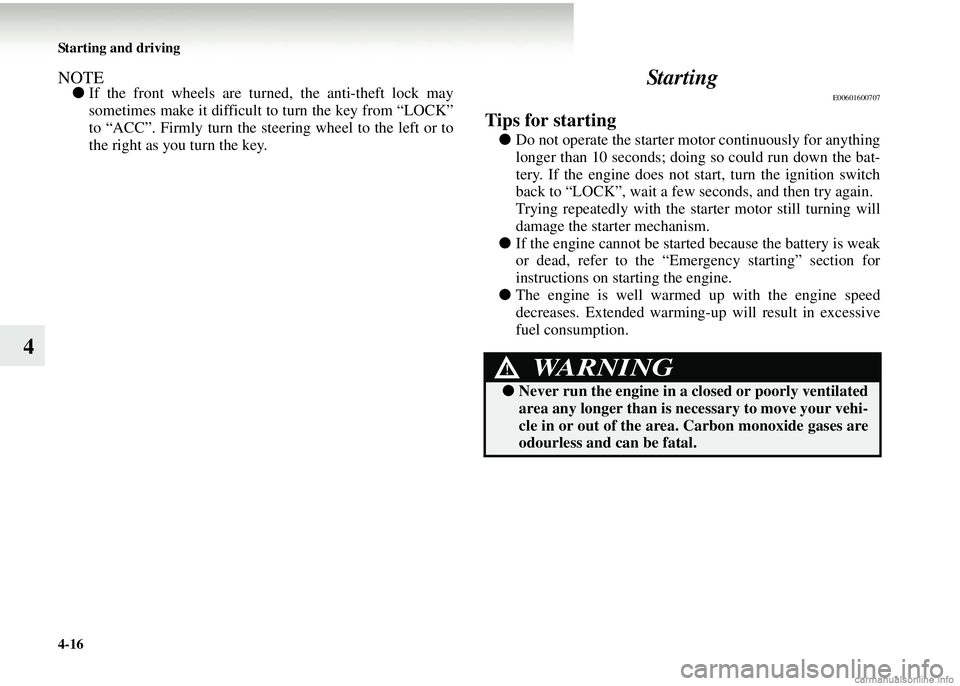
4-16 Starting and driving
4
NOTE●If the front wheels are turned , the anti-theft lock may
sometimes make it difficult to turn the key from “LOCK”
to “ACC”. Firmly turn the steer ing wheel to the left or to
the right as you turn the key.Starting
E00601600707
Tips for starting
● Do not operate the starter motor continuously for anything
longer than 10 seconds; doing so could run down the bat-
tery. If the engine does not start, turn the ignition switch
back to “LOCK”, wait a few seconds, and then try again.
Trying repeatedly with the starter motor still turning will
damage the starter mechanism.
● If the engine cannot be starte d because the battery is weak
or dead, refer to the “Emergency starting” section for
instructions on starting the engine.
● The engine is well warmed up with the engine speed
decreases. Extended warming-up will result in excessive
fuel consumption.
WARNING!
● Never run the engine in a cl osed or poorly ventilated
area any longer than is necessary to move your vehi-
cle in or out of the area. Carbon monoxide gases are
odourless and can be fatal.
Page 184 of 450
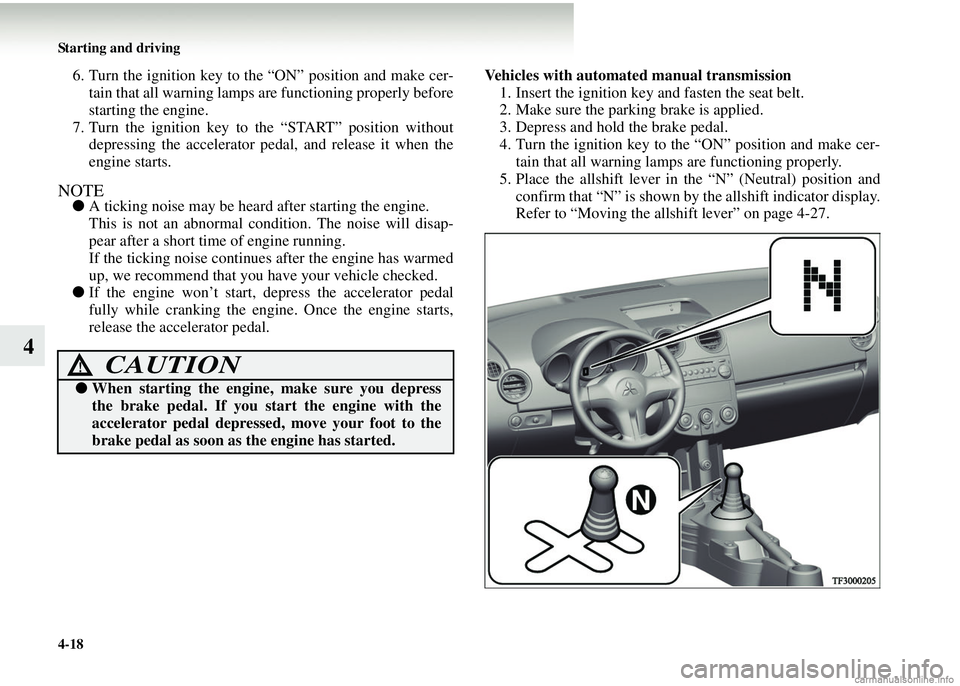
4-18 Starting and driving
4
6. Turn the ignition key to the “ON” position and make cer-tain that all warning lamps are functioning properly before
starting the engine.
7. Turn the ignition key to the “START” position without depressing the accelerator pedal, and release it when the
engine starts.
NOTE● A ticking noise may be heard after starting the engine.
This is not an abnormal condition. The noise will disap-
pear after a short time of engine running.
If the ticking noise continues after the engine has warmed
up, we recommend that you have your vehicle checked.
● If the engine won’t start, depress the accelerator pedal
fully while cranking the engi ne. Once the engine starts,
release the accelerator pedal. Vehicles with automated manual transmission
1. Insert the ignition key and fasten the seat belt.
2. Make sure the parking brake is applied.
3. Depress and hold the brake pedal.
4. Turn the ignition key to the “ON” position and make cer- tain that all warning lamps are functioning properly.
5. Place the allshift lever in the “N” (Neutral) position and confirm that “N” is shown by the allshift indicator display.
Refer to “Moving the allshift lever” on page 4-27.
CAUTION!
● When starting the engine, make sure you depress
the brake pedal. If you st art the engine with the
accelerator pedal depressed, move your foot to the
brake pedal as soon as the engine has started.
Page 197 of 450
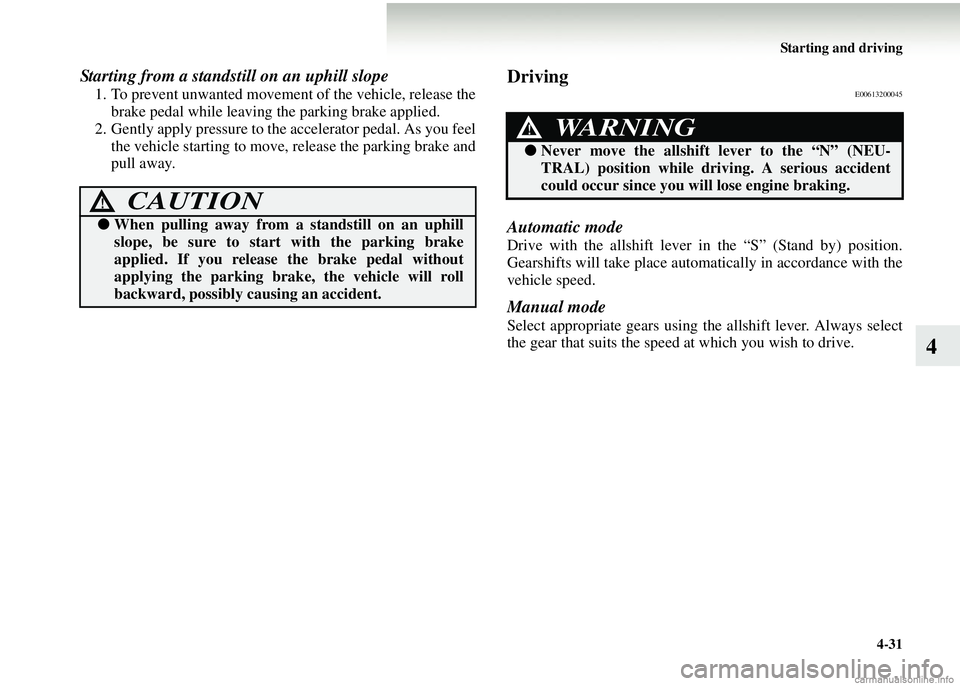
Starting and driving4-31
4
Starting from a standstill on an uphill slope
1. To prevent unwanted movement of the vehicle, release the
brake pedal while leaving the parking brake applied.
2. Gently apply pressure to th e accelerator pedal. As you feel
the vehicle starting to move, release the parking brake and
pull away.
DrivingE00613200045
Automatic mode
Drive with the allshift lever in the “S” (Stand by) position.
Gearshifts will take place automa tically in accordance with the
vehicle speed.
Manual mode
Select appropriate gears using th e allshift lever. Always select
the gear that suits the speed at which you wish to drive.
CAUTION!
●When pulling away from a standstill on an uphill
slope, be sure to start with the parking brake
applied. If you release the brake pedal without
applying the parking brak e, the vehicle will roll
backward, possibly causing an accident.
WARNING!
● Never move the allshift lever to the “N” (NEU-
TRAL) position while driv ing. A serious accident
could occur since you will lose engine braking.